#Atlandia Design
Text

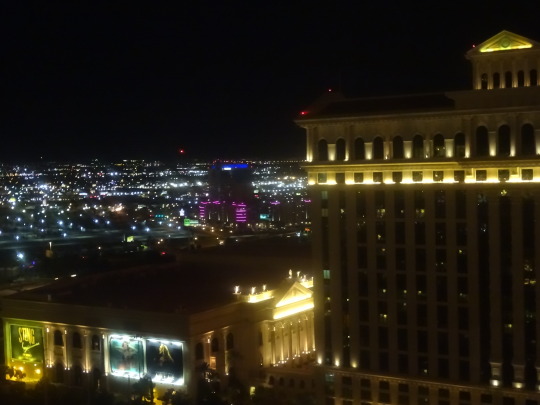





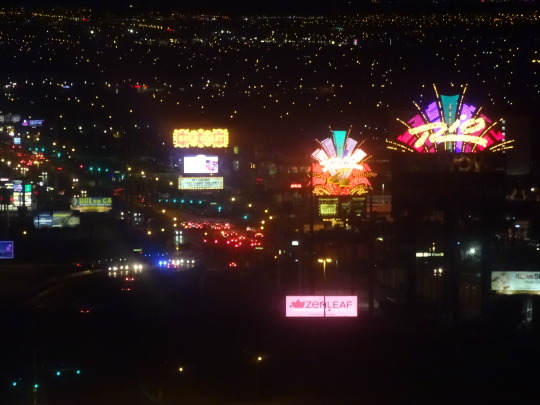


Room With A View, Las Vegas (No. 6)
The Las Vegas Beltway begins in Henderson at the I-11 / I-515 / US 93 / US 95 interchange, where traffic on westbound Nevada State Route 564 (SR 564, Lake Mead Parkway) defaults onto I-215 west. From here, the beltway primarily follows the former Lake Mead Drive alignment west to the Pecos Road / Saint Rose Parkway (SR 146) interchange. The highway then curves northwest toward Harry Reid International Airport before turning west to cross under Las Vegas Boulevard and I-15.
As the beltway passes under I-15, it changes from Interstate to county highway still maintaining freeway status as it heads nearly due west. Passing Decatur Boulevard, two one-way frontage roads (which formerly carried the initial beltway facilities) appear on either side of the highway. At Durango Drive, the roadway curves northward. The frontage roads end as the highway reaches Tropicana Avenue, but the freeway continues briefly west and then north again to intersect Charleston Boulevard (SR 159) near Red Rock Canyon. As it passes north through the community of Summerlin (part of the city of Las Vegas), the beltway meets Summerlin Parkway at a partial system interchange.
Source: Wikipedia
#neon light#rain clouds#night shot#lights#moon#Las Vegas Beltway#Interstate 215#3600 South Las Vegas Boulevard#Bellagio Hotel & Casino#Jon Jerde#Atlandia Design#Paradise#travel#original photography#vacation#tourist attraction#landmark#summer 2022#USA#cityscape#Nevada#exterior#view from hotel room#sunset#sundown#clouds#evening sky#golden light#landscape#countryside
3 notes
·
View notes
Photo

Section of scale model of Fremont Street Experience. Photographed Dec. 15, 1994, by Greg Cava. A 22-foot long scale model of Fremont Street Experience was built at the office of Atlandia Design, which supervised the creation of the attraction. Greg Cava Photograph Collection (PH-00399). UNLV Special Collections and Archives.
54 notes
·
View notes
Text


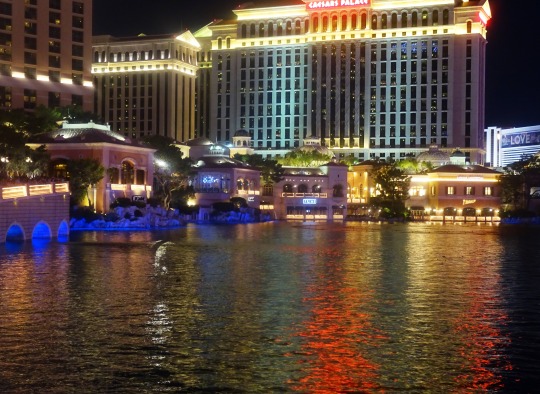

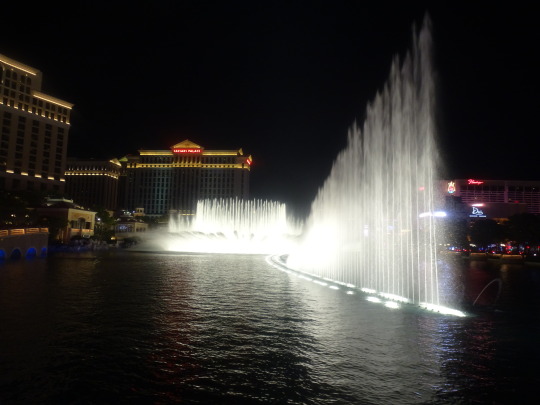





Bellagio Hotel & Casino, NV (No. 8)
The shows are widely visible and are typically viewed from the sidewalk along the Las Vegas Strip. Shows are free and usually performed every half-hour from the afternoon until midnight. A terrace overlooking the fountains has become a popular wedding spot, with the show coordinated to begin as couples kiss.
The fountains are controlled through computer programming. A control room overlooks the lake from a tower, and is staffed by an engineer who pushes a button to commence the fountain show. Water can be shot as high as 460 feet, up from 240 feet when the show debuted. Water is shot up using compressed air at a pressure of up to 500 pounds per square inch. Ten compressors are used to power the fountains. Wind is taken into consideration and the fountains are adjusted if necessary, to keep the show synchronized and prevent pedestrians from getting wet.
The show uses 1,214 water nozzles, which are divided into four types: oarsmen, mini-shooters, super-shooters, and extreme-shooters. Oarsmen shoot water 77 feet in the air. The lake contains 208 oarsmen, each one capable of moving 140 gallons a minute. To meet the resort's opening deadline, WET subcontracted some of the work. The oarsmen were created by Sarcos, which was to manufacture them at a cost of $12,000 each. However, the cost more than doubled, due to unexpected challenges in their design and engineering. The oarsmen were designed to last five years, but were still in use as of 2017, thanks to maintenance and improvements made by the show's team. The oarsmen were mostly made of mild steel, and a tar-based coating of paint wore off after the first year. The team removed all the oarsmen and sandblasted them before applying powder coating.
The lake also contains 798 mini-shooters, 192 super-shooters and 16 extreme-shooters, respectively capable of shooting water 100, 240 and 460 feet high. The extreme-shooters were added in 2005. Regular maintenance takes place on the equipment. For instance, barnacles are routinely sandblasted off of the fountain mechanisms. The attraction has 4,792 fountain lights. Wynn considered using colored fountain lights, before settling on white ones, which he found more elegant.
Source: Wikipedia
#Fountains of Bellagio#3600 South Las Vegas Boulevard#Bellagio Hotel & Casino#Jon Jerde#Atlandia Design#Paradise#travel#original photography#vacation#tourist attraction#landmark#flora#street scene#summer 2022#USA#architecture#cityscape#Nevada#public art#exterior#night shot#WET#reflection
2 notes
·
View notes
Text



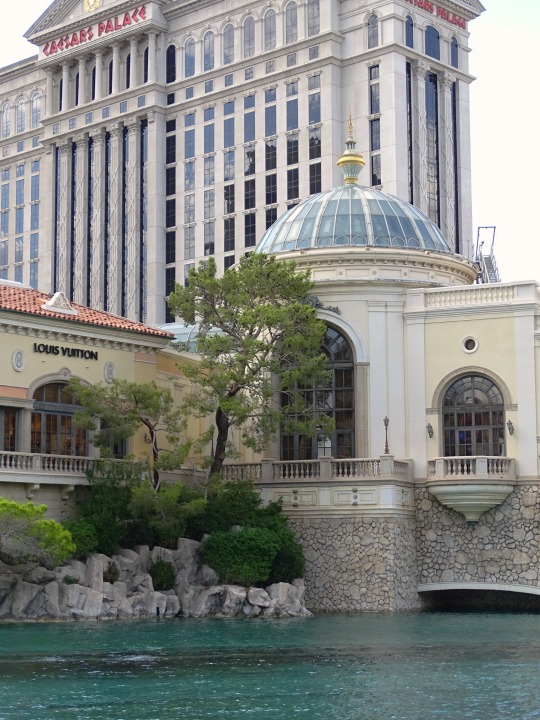

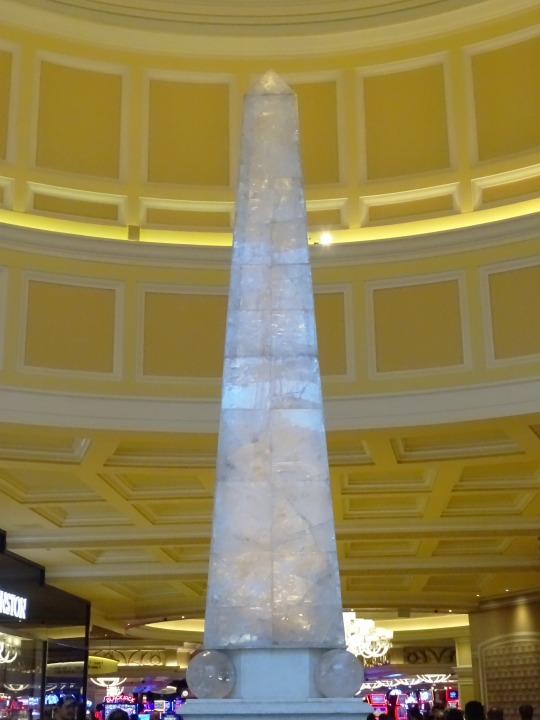



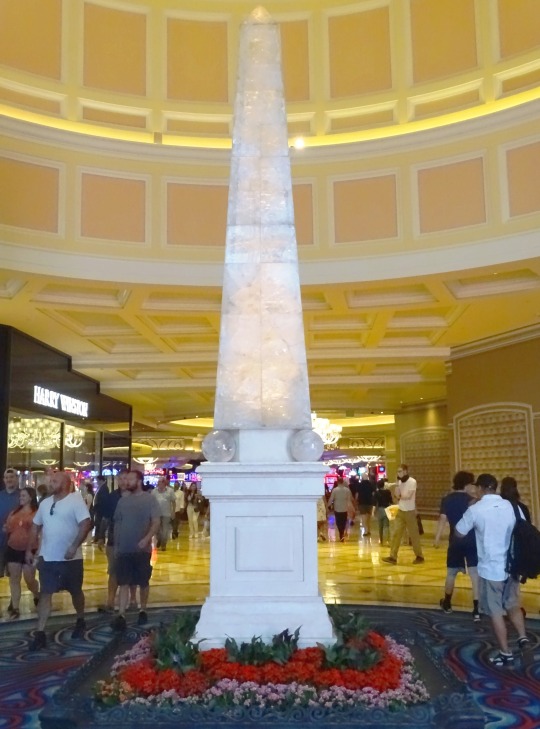
Bellagio Hotel & Casino, NV (No. 3)
Construction began on November 1, 1995, and the opening was initially scheduled for March 1998. Marnell Corrao Associates served as general contractor. The project's cost increased several times, in part because of new features being added. A shortage of skilled workers also resulted in rising labor costs. It was financed through various lenders. Finished at a cost of $1.6 billion, it was the most expensive resort ever built.
Wynn envisioned the Bellagio as a five-star resort catering to tourists who typically visit places other than Las Vegas, such as Paris, London, or Venice. He said the Bellagio would "redefine Las Vegas", describing it as the "most ambitious" and luxurious project ever attempted by Mirage Resorts. He also said it would be "the most romantic, delicious place ever built in the world", as well as the "greatest" and "most beautiful" hotel ever.
The property features a variety of trees. Before the opening, builders spent more than a year searching the western U.S. for mature Japanese privets, which are capable of withstanding the dry Las Vegas heat. A deal was reached to remove approximately 30 privets from the government center in Ventura County, California, and replant them at the Bellagio, at a cost of nearly $10,000 per tree. The resort's pool area is surrounded by a Mediterranean garden that included nearly 300 pine trees, left over from the Dunes golf course.
Source: Wikipedia
#3600 South Las Vegas Boulevard#Bellagio Hotel & Casino#Jon Jerde#Atlandia Design#interior#exterior#Paradise#travel#original photography#vacation#tourist attraction#landmark#flora#street scene#summer 2022#USA#architecture#cityscape#Nevada#logo#Fountains of Bellagio#Via Bellagio#porte-cochère
3 notes
·
View notes
Text
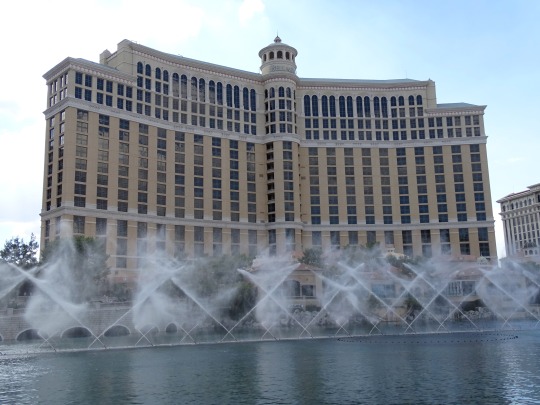
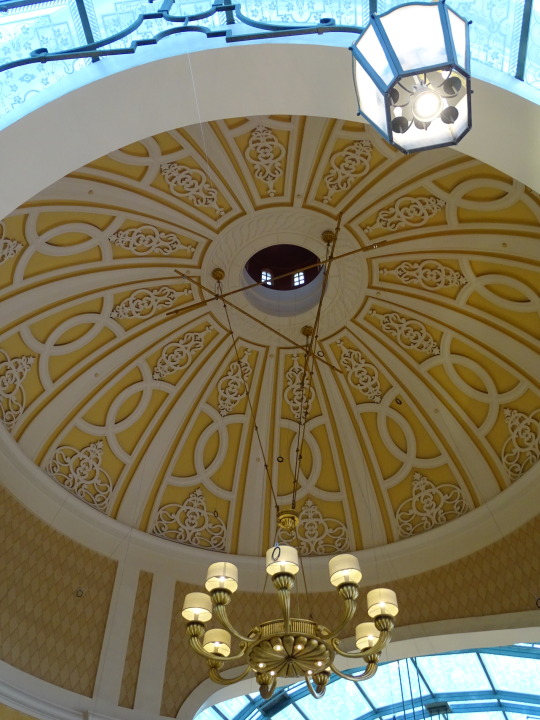


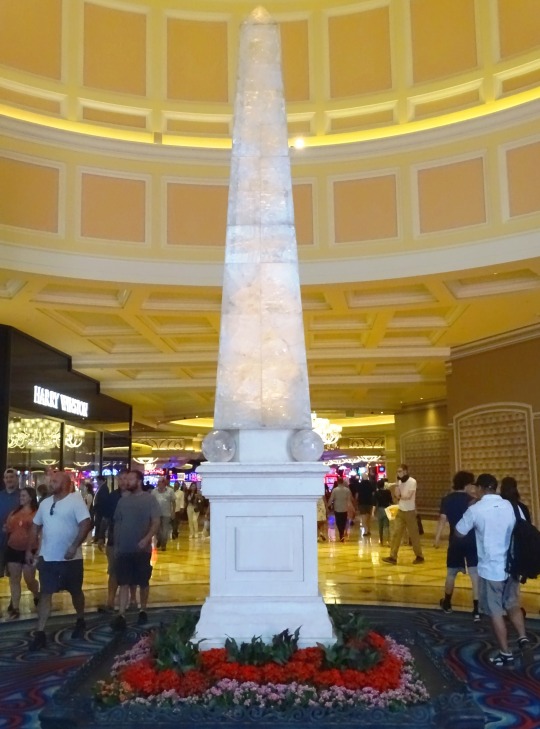
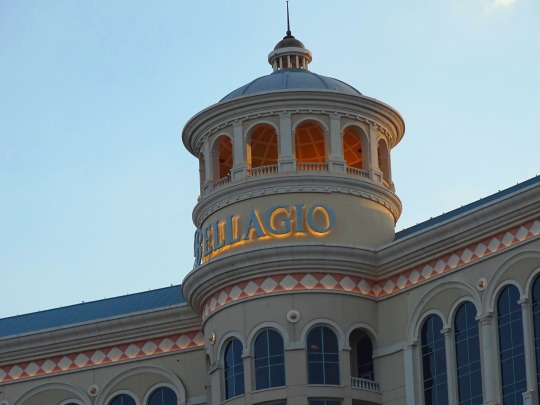


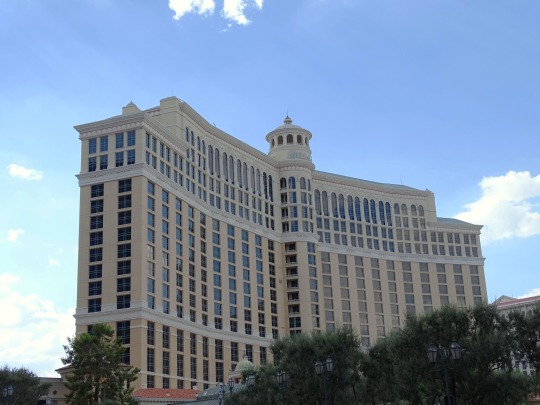


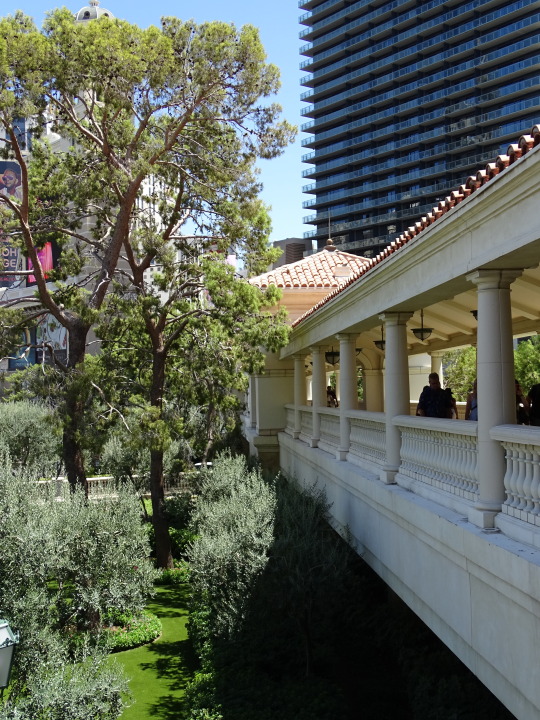
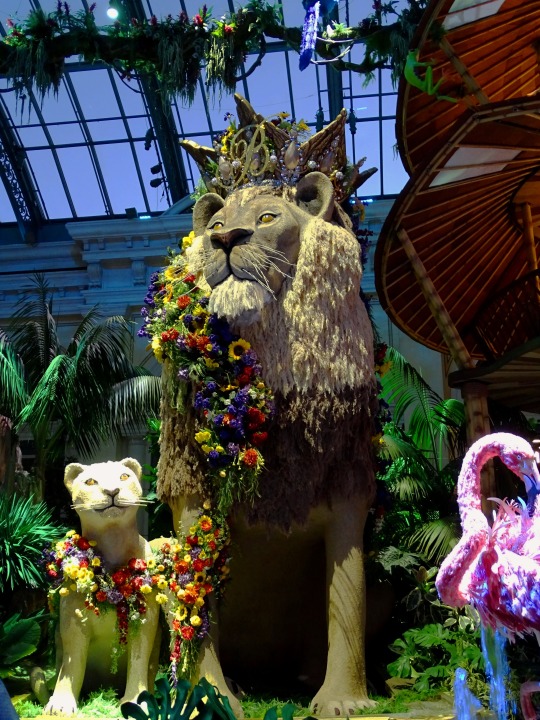

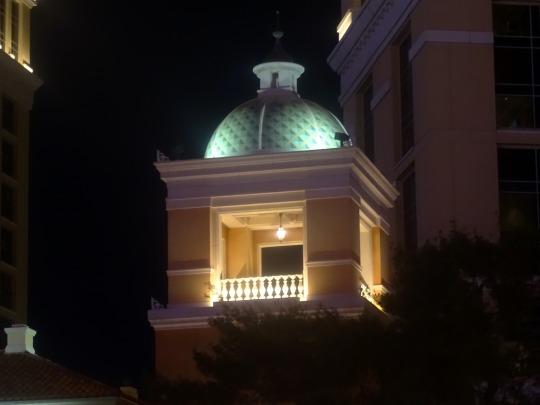

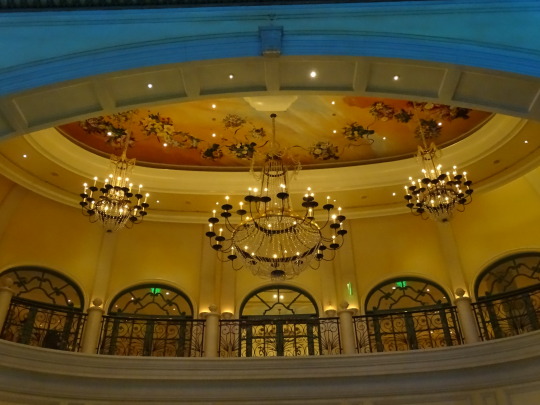
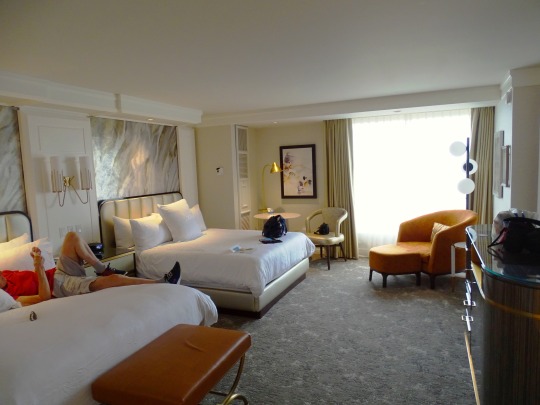
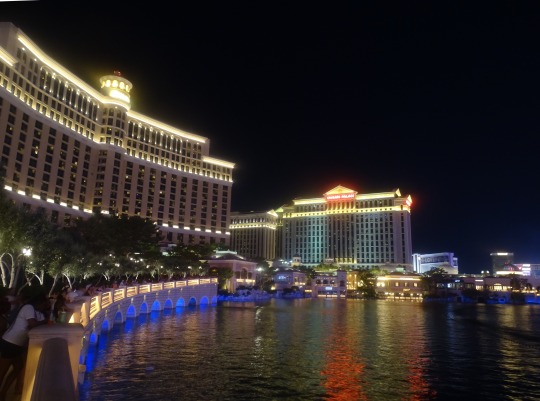
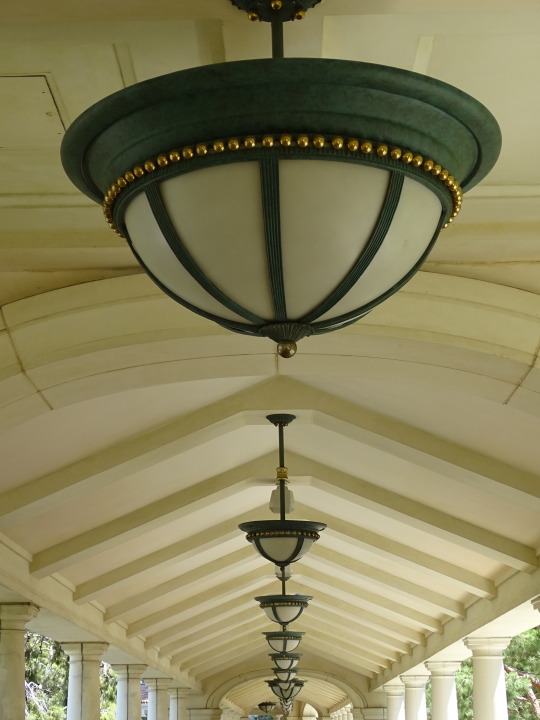


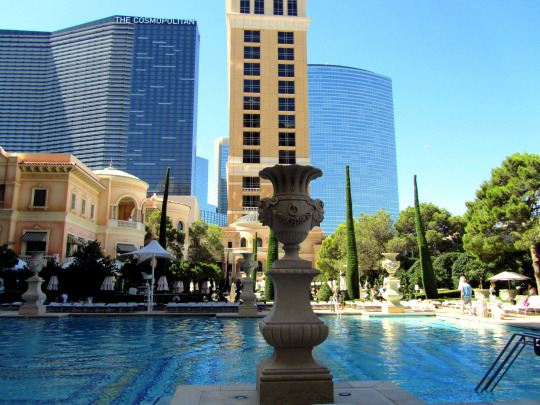

The Bellagio - Las Vegas Luxury Resort & Casino opened on October 15, 1998.
#Bellagio - Las Vegas Luxury Resort & Casino#Bellagio Fountains#exterior#interior#hotel room#travel#vacation#Paradise#Nevada#USA#landmark#Conservatory and botanical gardens#Fiori di Como by Dale Chihuly#lobby#architecture#Jon Jerde#Atlandia Design#3600 South Las Vegas Boulevard#opened#15 October 1998#25th anniversary#US history#summer 2022#Jungle of Dreams#cityscape#pool
2 notes
·
View notes
Photo



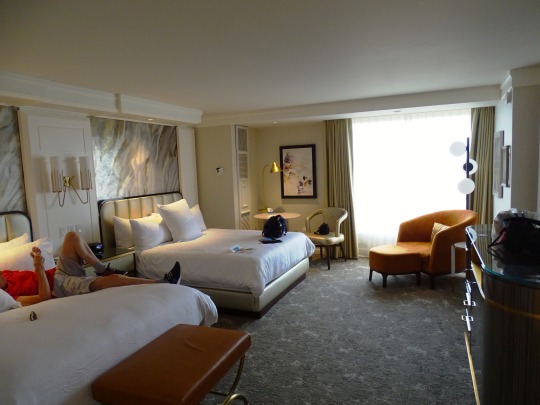






The Bellagio - Las Vegas Luxury Resort & Casino opened on October 15, 1998.
#Bellagio - Las Vegas Luxury Resort & Casino#Bellagio Fountains#exterior#interior#hotel room#travel#vacation#Paradise#Nevada#USA#landmark#Conservatory and botanical gardens#Fiori di Como by Dale Chihuly#lobby#architecture#Jon Jerde#Atlandia Design#3600 South Las Vegas Boulevard#opened#15 October 1998#anniversary#US history#summer 2022#Jungle of Dreams#cityscape
3 notes
·
View notes
Text

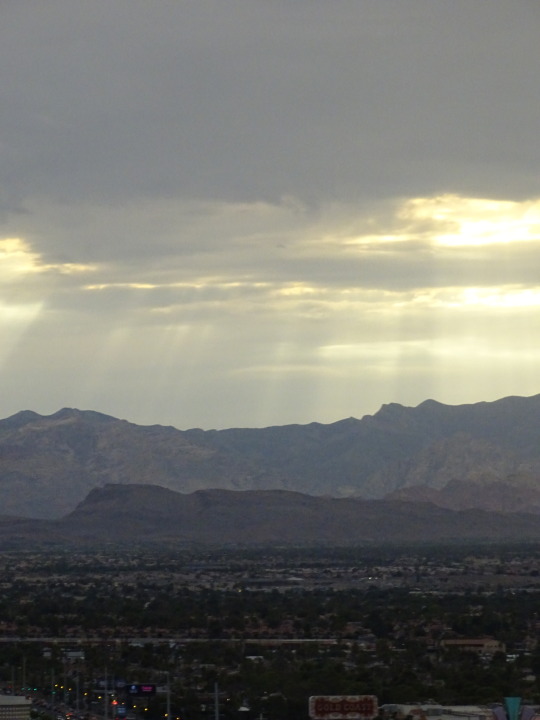


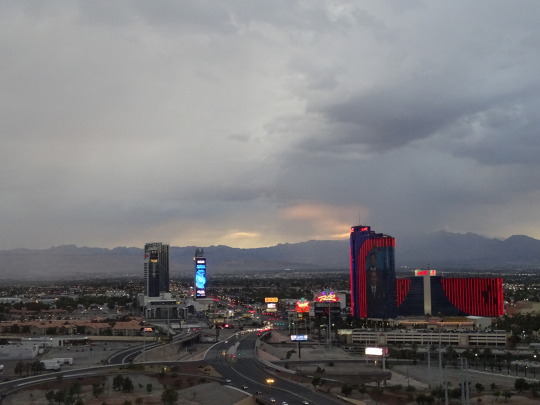

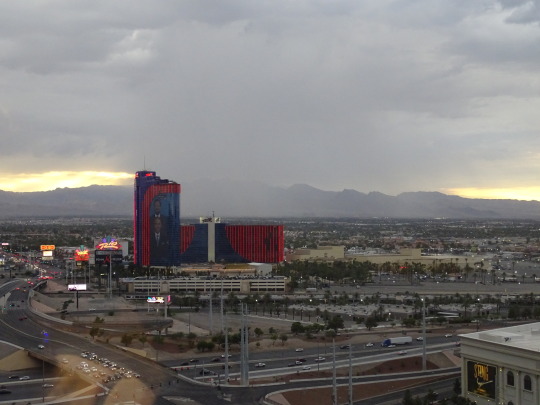

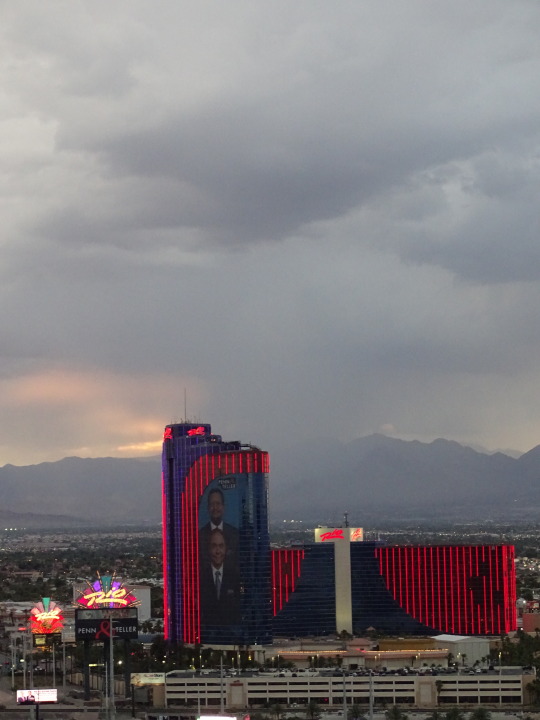

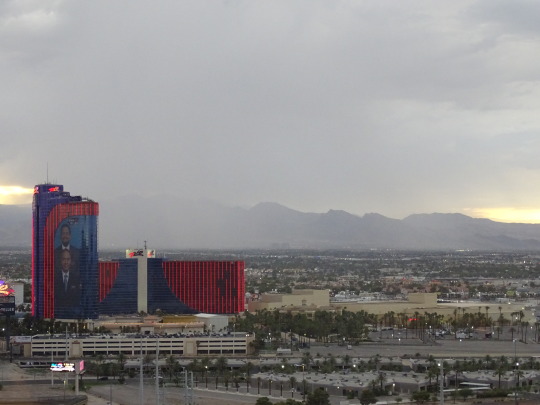
Room With A View, Las Vegas (No. 7)
From here, the freeway continues north along the western foothills of Las Vegas to pass behind Lone Mountain. Soon afterward, the beltway curves to the east and downgrades from freeway to an expressway (with two at-grade intersections at US 95 south, Oso Blanca Road and Sky Pointe Drive) after it passes the Durango Drive interchange and intersects US 95 at an interchange currently under construction. From there, the beltway continues as a freeway nearly due east along the alignment of Centennial Parkway before entering northern North Las Vegas at Decatur Boulevard. From there, it swings northeast, passing by the large Aliante development before turning east again. Much of the final few miles of the route, from here on, are in undeveloped land, except near the interchange at North 5th Street. The beltway has additional interchanges at Losee Road, North Pecos Road, and North Lamb Boulevard before it swings southeast and reaches its clockwise terminus at I-15, US 93, and Tropical Parkway at an at-grade diamond interchange just west of the Las Vegas Motor Speedway.
Source: Wikipedia
#morning light#neon light#rain clouds#night shot#lights#moon#Las Vegas Beltway#Interstate 215#3600 South Las Vegas Boulevard#Bellagio Hotel & Casino#Jon Jerde#Atlandia Design#Paradise#travel#original photography#vacation#tourist attraction#landmark#summer 2022#USA#cityscape#Nevada#exterior#view from hotel room#clouds#landscape#countryside
1 note
·
View note
Text
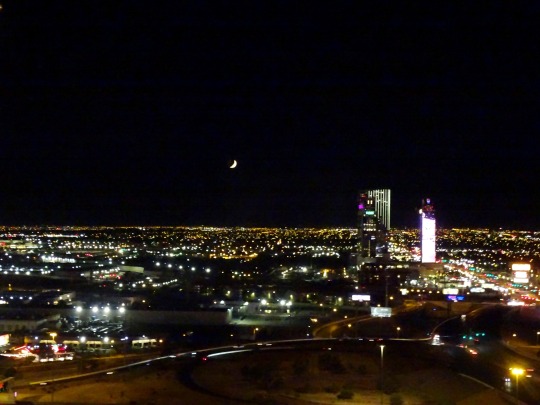


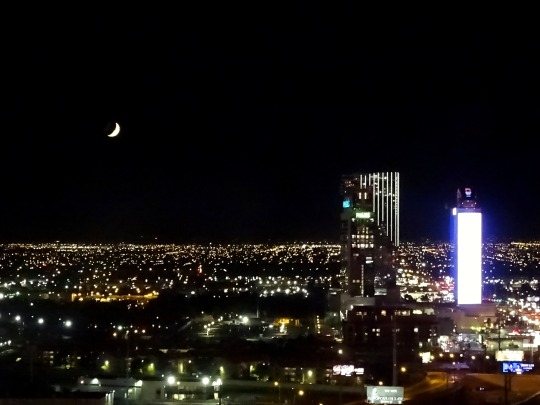





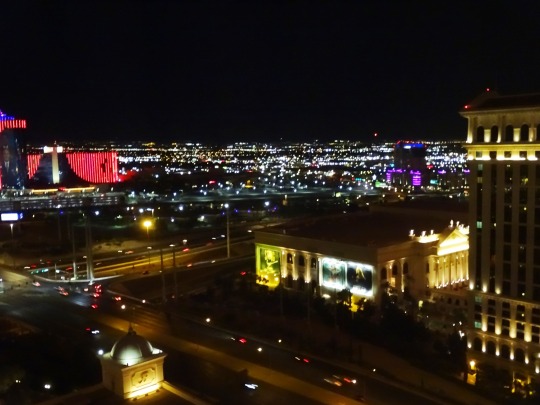
Room With A View, Las Vegas (No. 5)
The Las Vegas Beltway (officially named the Bruce Woodbury Beltway) is a 50-mile (80 km) beltway route circling three-quarters of the Las Vegas Valley in southern Nevada. The Las Vegas Beltway carries two numerical designations. Approximately 12.8 miles (20.6 km) of the highway, from its southern terminus at Interstate 11 (I-11) / I-515 / U.S. Route 93 (US 93) / US 95 in Henderson west and northwest to I-15, is signed as Interstate 215 (I-215) and maintained by the Nevada Department of Transportation.[2] Clark County Route 215 (CC 215) composes the remaining 37.2 miles (59.9 km) of this semi-circumferential highway, with the county's Department of Public Works responsible for all construction and maintenance.
The Las Vegas Beltway currently consists of two different road types: freeway and an interim expressway. The beltway is currently a freeway from the I-11/I-515 interchange in Henderson to just west of US 95 in northwest Las Vegas. The remainder of the beltway is a mix of freeway and expressway, with several of the expressway sections being upgraded to Interstate freeway standards.
The beltway was planned and constructed by Clark County. This marked the first time in the United States that a county had overseen the construction of an Interstate highway with little to no state or federal funding. Once completely upgraded to a freeway, the CC 215 portion of the beltway will be redesignated I-215 and the entire facility turned over to the Nevada Department of Transportation for maintenance.
Source: Wikipedia
#night shot#lights#moon#Las Vegas Beltway#Interstate 215#3600 South Las Vegas Boulevard#Bellagio Hotel & Casino#Jon Jerde#Atlandia Design#Paradise#travel#original photography#vacation#tourist attraction#landmark#summer 2022#USA#cityscape#Nevada#exterior#view from hotel room#sunset#sundown#clouds#evening sky#golden light#landscape#countryside
0 notes
Text





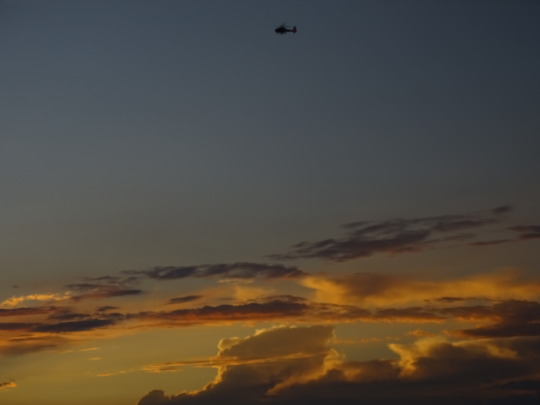

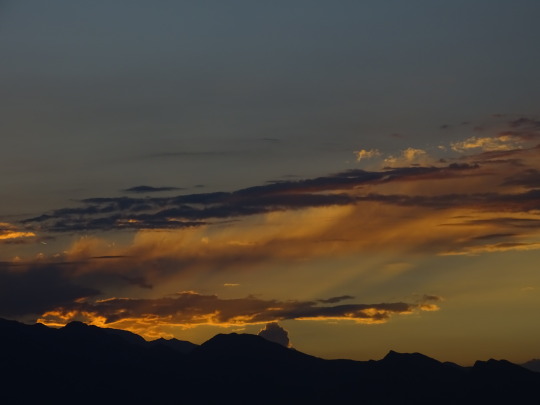


Room With A View, Las Vegas (No. 4)
According to the United States Census Bureau, the census-designated place (CDP) of Paradise (which may not coincide exactly with the town boundaries) has a total area of 46.7 square miles (121 km2), all of it land.
The official town boundaries are bordered by Desert Inn Road to the north, Nellis Boulevard to the east, Sunset Road to the south and Decatur Boulevard to the west. There is a southern finger between Bermuda Road and Eastern Avenue south to Silverado Ranch Boulevard. South of Russell Road, the eastern border stairsteps on a rough 45-degree angle toward the corner of Eastern and Robindale Road, and there is an additional finger surrounding Interstate 215 east to St. Rose Parkway.
Source: Wikipedia
#3600 South Las Vegas Boulevard#Bellagio Hotel & Casino#Jon Jerde#Atlandia Design#Paradise#travel#original photography#vacation#tourist attraction#landmark#summer 2022#USA#cityscape#Nevada#night shot#exterior#view from hotel room#sunset#sundown#clouds#evening sky#golden light#landscape#countryside
0 notes
Text
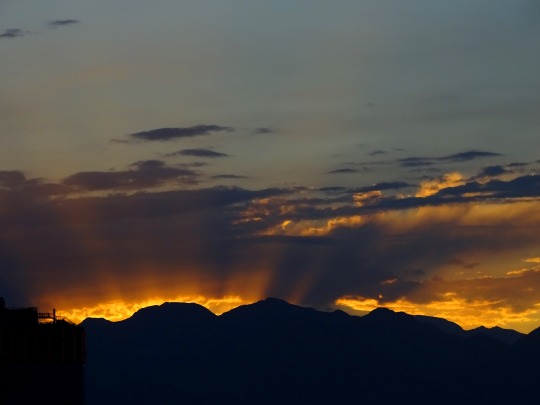






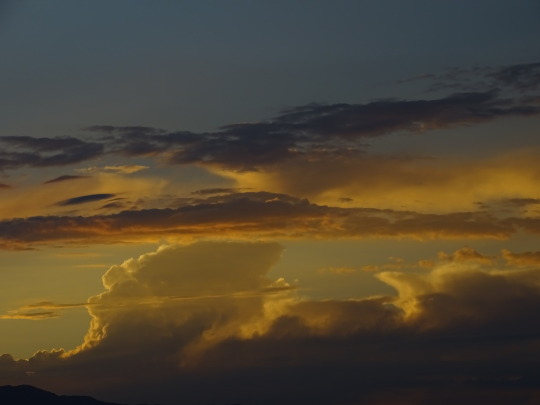


Room With A View, Las Vegas (No. 3)
A month after its establishment, the town was expanded to include the residential areas of Paradise Valley, giving it a total area of 54 square miles (140 km2). Months later, however, it was reported that county officials had determined that the town had not been properly established, because the petition for the town's formation had an insufficient number of signatures and because it had violated a state law forbidding formation of a town spanning multiple school districts. On August 20, 1951, county commissioners accepted petitions to create two new towns covering the area of the putative town. Town "A" of Paradise included the areas that lay within a Las Vegas school district, extending from the city limits to a point one mile south, while Town "B" included the areas within the Paradise school district.
In 1953, Town A was renamed as Winchester, and Town B became known simply as Paradise.
In 1975, Nevada enacted a law that would have incorporated Paradise (along with Sunrise Manor and Winchester) into the City of Las Vegas. Before it could take effect, however, the bill was struck down as unconstitutional by the Nevada Supreme Court.
Source: Wikipedia
#3600 South Las Vegas Boulevard#Bellagio Hotel & Casino#Jon Jerde#Atlandia Design#Paradise#travel#original photography#vacation#tourist attraction#landmark#summer 2022#USA#cityscape#Nevada#night shot#exterior#view from hotel room#sunset#sundown#clouds#evening sky#golden light#landscape#countryside
1 note
·
View note
Text
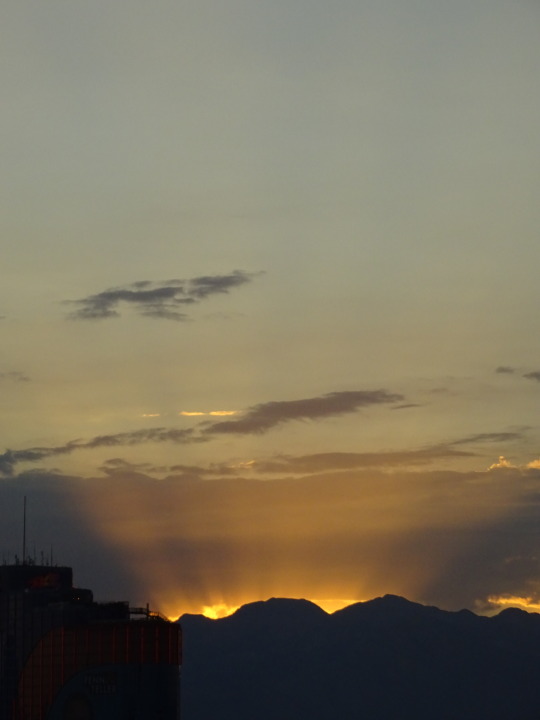






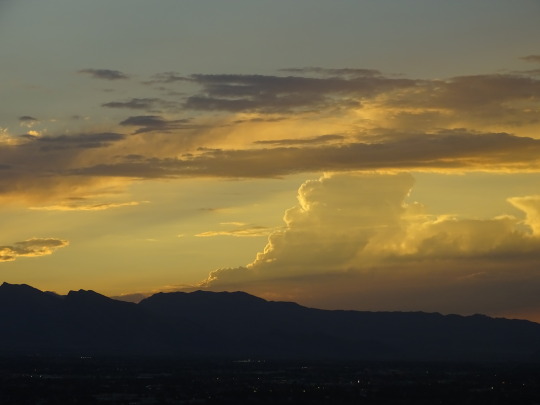
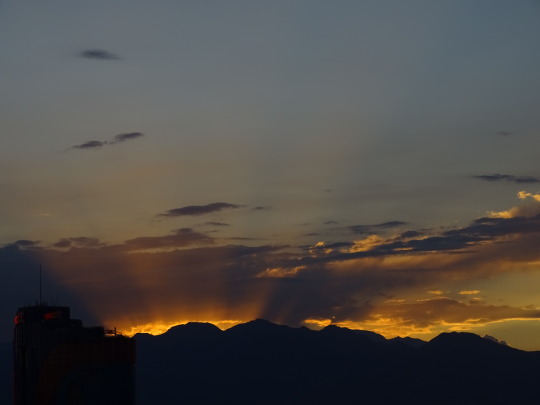

Room With A View, Las Vegas (No. 2)
The southern part of the Las Vegas Valley was referred to as Paradise Valley as early as 1910, owing to a high water table that made the land particularly fertile for farming. County commissioners established a Paradise school district in 1914. Neighborhoods on the east side of Paradise
In 1950, mayor Ernie Cragin of Las Vegas sought to annex the Las Vegas Strip, which was unincorporated territory, in order to expand the city's tax base to fund his ambitious building agenda and pay down the city's rising debt. A group of casino executives, led by Gus Greenbaum of the Flamingo, lobbied the county commissioners for town status, which would prevent the city from annexing the land without the commission's approval. The commission voted to create the unincorporated town of Paradise on December 8, 1950. The town encompassed a strip one mile (1.6 km) wide and four miles (6.4 km) long, from the southern city limits of Las Vegas to just south of the Flamingo. The town board initially consisted of five casino managers, chaired by Greenbaum.
Source: Wikipedia
#3600 South Las Vegas Boulevard#Bellagio Hotel & Casino#Jon Jerde#Atlandia Design#Paradise#travel#original photography#vacation#tourist attraction#landmark#summer 2022#USA#cityscape#Nevada#night shot#exterior#view from hotel room#sunset#sundown#clouds#evening sky#golden light#landscape#countryside
0 notes
Text






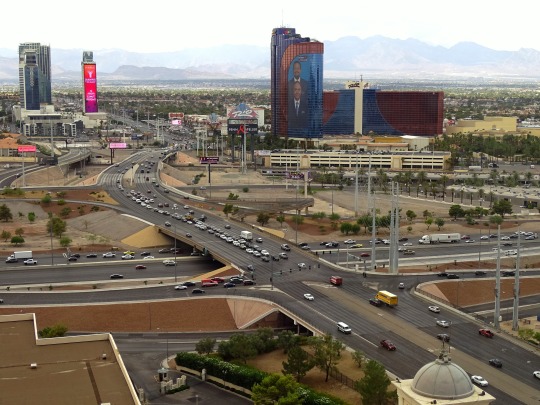
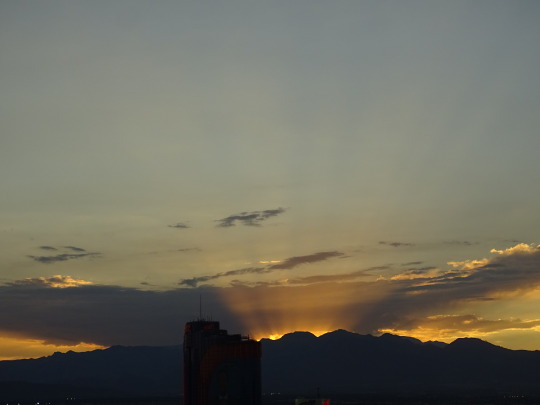


Room With A View, Las Vegas (No. 1)
Paradise is an unincorporated town and census-designated place (CDP) in Clark County, Nevada, United States, adjacent to the city of Las Vegas. It was formed on December 8, 1950. Its population was 191,238 at the 2020 census, making it the fifth-most-populous CDP in the United States; if it were an incorporated city, it would be the fifth-largest in Nevada. As an unincorporated town, it is governed by the Clark County Commission with input from the Paradise Town Advisory Board.
Paradise contains Harry Reid International Airport, the University of Nevada, Las Vegas (UNLV), most of the Las Vegas Strip, and most of the tourist attractions in the Las Vegas area (excluding downtown).
Source: Wikipedia
#3600 South Las Vegas Boulevard#Bellagio Hotel & Casino#Jon Jerde#Atlandia Design#Paradise#travel#original photography#vacation#tourist attraction#landmark#summer 2022#USA#cityscape#Nevada#night shot#exterior#view from hotel room#sunset#sundown#clouds#evening sky#golden light#landscape#countryside#Interstate 215
1 note
·
View note
Text




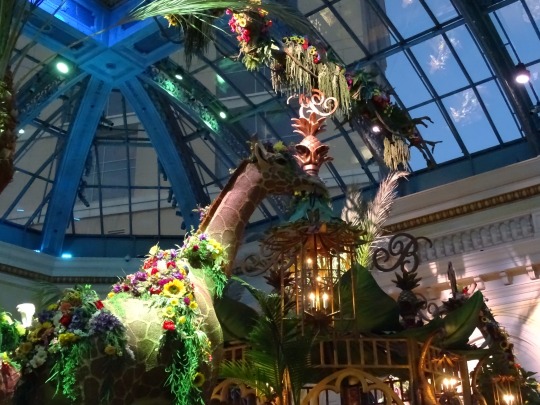




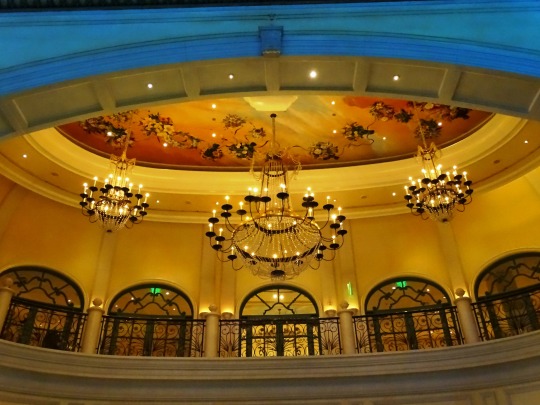
Bellagio Hotel & Casino, NV (No. 11)
Bellagio is a member of The Leading Hotels of the World, and various organizations have ranked the resort highly. By 2001, it had achieved a four-star rating from Mobil Travel Guide. That year, it became the first hotel-casino to win the AAA Five Diamond Award. It was also the second Las Vegas hotel to win the award, after the Four Seasons in 1999. In 2010, Bellagio won its 10th consecutive Five Diamond Award, the first Strip resort to do so. As of 2020, it had won the Five Diamond Award 18 consecutive times.
Bellagio placed eighth in the 2003 Zagat Survey of U.S. hotel resorts, while its restaurants ranked 12th in the category of top dining.[282] Bellagio has also made the Condé Nast Traveler Gold List numerous times, beginning in 2005. A 2005 study by Majestic Research, polling more than 400 out-of-state residents, found Bellagio to be the favorite resort among tourists, with 18 percent support.[285] Another study polled tourists who visited Las Vegas in 2005, and Bellagio was named the city's top "must-see" resort, while the fountains were named best "must-see" attraction.[286] In 2010, Travel + Leisure ranked it 31st on a list of top hotels in large U.S. and Canadian cities. Travelocity ranked it in sixth place in a 2011 list of top 10 Las Vegas hotels, based on guest reviews.
The resort's Picasso restaurant has also been critically acclaimed, receiving the AAA Five Diamond and Mobil Five-Star awards by the end of 2001. In 2010, the restaurant won its 10th Five Diamond Award, while Le Cirque won its 8th. Bellagio was the only hotel in the U.S. to have two Five Diamond restaurants.
Source: Wikipedia
#Bellagio Conservatory & Botanical Gardens#Jungle of Dreams#flowers#flora#indoors#3600 South Las Vegas Boulevard#Bellagio Hotel & Casino#Jon Jerde#Atlandia Design#Paradise#travel#original photography#vacation#tourist attraction#landmark#summer 2022#USA#architecture#cityscape#Nevada#night shot#free attraction#exterior#Fountains of Bellagio
0 notes
Text


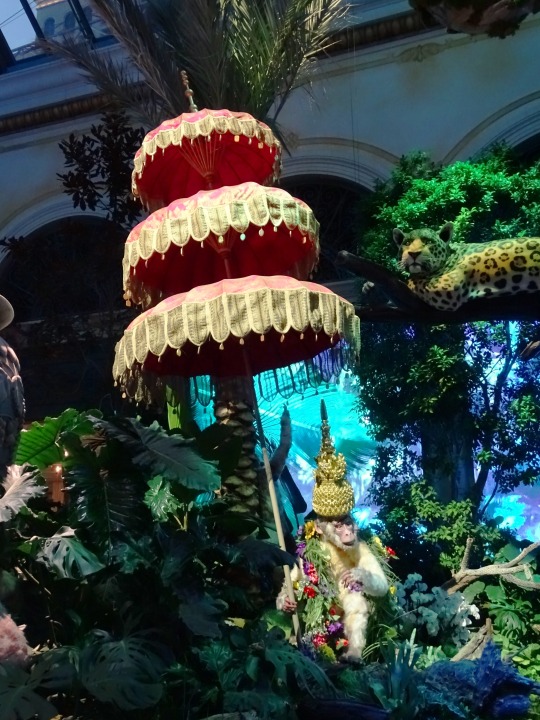




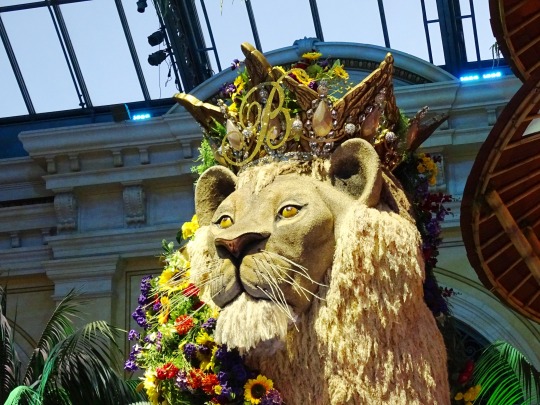


Bellagio Hotel & Casino, NV (No. 10)
The resort contains a 13,500 sq ft conservatory and botanical gardens. It is located next to the hotel's lobby and is open free to the public.[235][221] It receives an average of 20,000 visitors daily. The Conservatory was originally planned as an outdoor garden.
There are five seasonal themes that the Conservatory undergoes: Chinese New Year, spring, summer, fall, and winter. From January to mid-March, the Conservatory celebrates the Chinese New Year with a display dominated by flowers bromeliads and orchids, as well as the animal of that particular year that the Chinese zodiac celebrates.The theme then changes over to the spring display, which lasts until May, and usually features a butterfly house as well as many varieties of tropical flowers.
Source: Wikipedia
#Bellagio Conservatory & Botanical Gardens#Jungle of Dreams#flowers#flora#indoors#3600 South Las Vegas Boulevard#Bellagio Hotel & Casino#Jon Jerde#Atlandia Design#Paradise#travel#original photography#vacation#tourist attraction#landmark#summer 2022#USA#architecture#cityscape#Nevada#night shot#free attraction
0 notes
Text



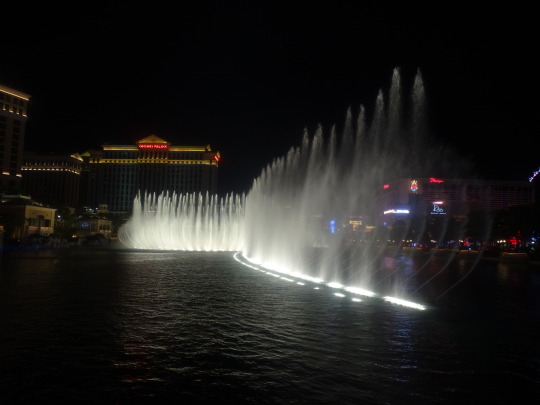









Bellagio Hotel & Casino, NV (No. 9)
The lake is sometimes referred to as Lake Bellagio or Lake Como. It is loosely based on northern Italy's Lake Como, located near the village of Bellagio, Lombardy. The lake is 8.5 acres. It measures 1,200 feet by 600 feet, and its depth ranges from 4 to 13 feet. The lake contains 22 million gallons of water. It is partly filled with well water, which was previously used for the Dunes golf course. The lake uses two-thirds of the water previously used for the course. Water from the resort's aquatic show, O, also drains into the lake.
Approximately 12 million gallons are used each year for the fountain shows, and the lake uses roughly 500 pounds of chlorine per day. Several restaurants at the Bellagio resort are situated to overlook the lake.The water temperature ranges from 50 degrees in the winter to 85 degrees in the summer. It is frequented by ducks, some of which have made it their permanent home.
The operating and maintenance team works in a hidden cavern known as the Batcave, located within a fake rock formation beside the lake. The Batcave contains four equipment rooms. The team consists of 30 people, including computer technicians, electricians, and welders. Due to the amount of time spent in the water, all team members are trained scuba divers.
Various items are thrown or dropped into the lake from bystanders, including food, keys, cellphones, lingerie, casino chips, military coins, foreign coinage, and wedding rings. The lake's filtration system is capable of cleaning five million gallons per day. Every few weeks, a barge resembling an ice resurfacer is used to clean the lake's bottom and retrieve foreign objects. Coins recovered from the lake are donated to charities. Approximately two tons of coins are recovered each year. There have been several instances of people jumping into the lake, including a homeless man who drowned in 2020.
In 2004, to promote a Victoria's Secret model tour, the lake was temporarily turned pink with the use of gels on the lenses of the underwater lights.
Source: Wikipedia
#Fountains of Bellagio#3600 South Las Vegas Boulevard#Bellagio Hotel & Casino#Jon Jerde#Atlandia Design#Paradise#travel#original photography#vacation#tourist attraction#landmark#flora#street scene#summer 2022#USA#architecture#cityscape#Nevada#public art#exterior#night shot#WET#reflection
1 note
·
View note
Text

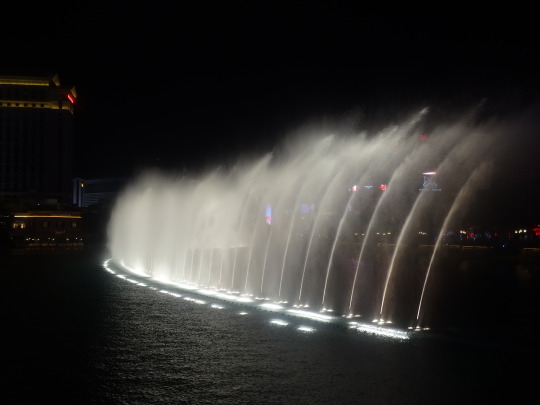
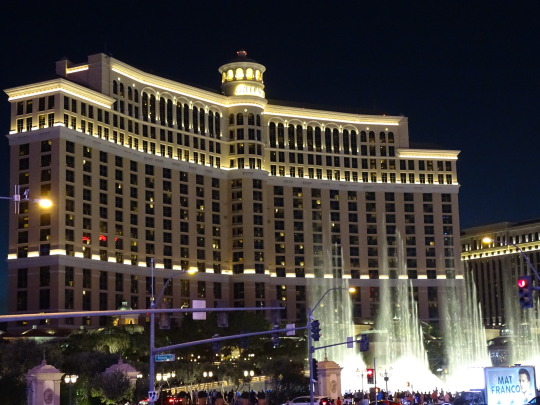




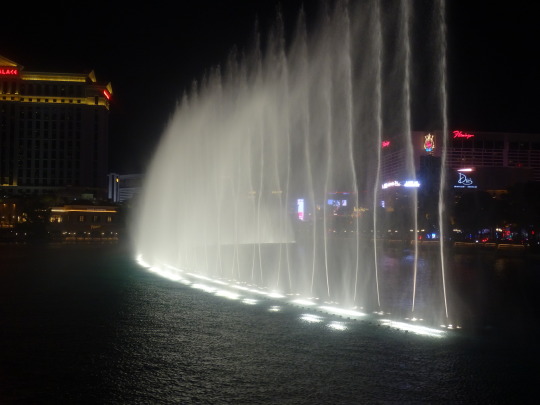


Bellagio Hotel & Casino, NV (No. 7)
Fountains of Bellagio is a free attraction at the Bellagio resort, located on the Las Vegas Strip in Paradise, Nevada. It consists of a musical fountain show performed in an 8.5-acre (3.4 ha) man-made lake in front of the resort. The show uses 1,214 water nozzles and 4,792 lights. The fountains shoot as high as 460 feet. Stages are sometimes built on the lake to host events, such as musical performances, that incorporate the fountain show.
It was conceived by owner Steve Wynn, and built by the design firm WET. Work began on the fountain show in 1995, and it opened with the resort on October 15, 1998. The attraction was built for $40 million, making it one of the most expensive fountains in the world. The Fountains of Bellagio have appeared in numerous films. It is a signature attraction for Las Vegas, and one of the most photographed places in the United States. It was the largest fountain show in the world until The Dubai Fountain opened in 2009.
The Fountains of Bellagio opened on October 15, 1998, along with the Bellagio resort, both built on the former site of the Dunes hotel-casino. The shows take place in a man-made lake in front of the resort. The Bellagio and its fountain attraction were conceived by casino owner Steve Wynn. The attraction was created by the design firm WET, which had never created such a large project before. Work began on the attraction in 1995, and it was completed at a cost of $40 million. It was one of the most expensive fountains in the world.
The fountains are among the most photographed places in the United States. It was the largest fountain show in the world until The Dubai Fountain, also by WET, was opened in 2009. After leaving the Bellagio in 2000, Wynn would later include a water show at his Wynn Macau and Wynn Palace resorts.
More than 240,000 fountain shows had been performed at the Bellagio as of October 2018. A new edition of the show, promoting the final season of Game of Thrones, was unveiled in 2019 and ran for two weeks. Scenes from the television show were projected onto a wall of water formed by the fountains, and new technology was installed to shoot flames up from the surface of the water. Music from the series was also incorporated into the fountain show.
The Fountains of Bellagio have been closed on several occasions, for instance during a three-day power outage at the resort in 2004. Shows are also canceled if winds reach 25 miles per hour. As of 2005, only five shows had ever been canceled because of technical problems. The show was temporarily closed in March 2020, amid the COVID-19 pandemic. It returned two and a half months later.
Source: Wikipedia
#Fountains of Bellagio#3600 South Las Vegas Boulevard#Bellagio Hotel & Casino#Jon Jerde#Atlandia Design#Paradise#travel#original photography#vacation#tourist attraction#landmark#flora#street scene#summer 2022#USA#architecture#cityscape#Nevada#public art#exterior#night shot#WET
1 note
·
View note